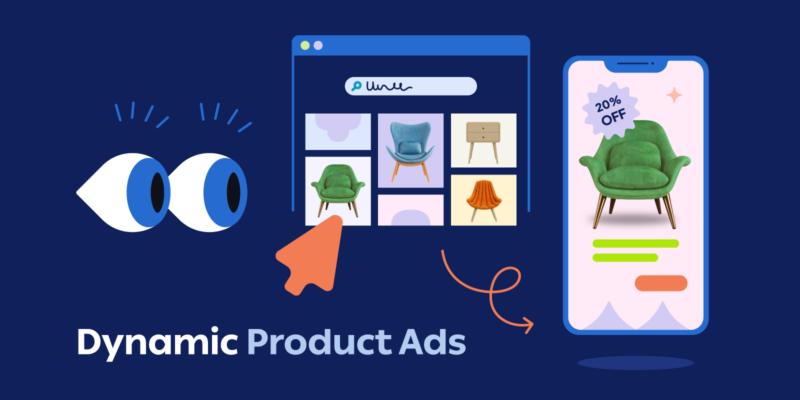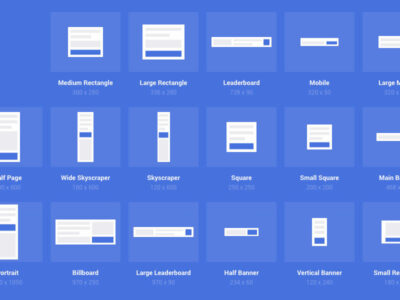In an era where users routinely disclose personal information online, and cookies meticulously trace every click (not for long, though), marketers have gained unparalleled insights into consumer behavior. This abundance of insights allows them to craft tailored solutions to meet individual needs.
The use of behavioral targeting can significantly enhance the response to ads, and when marketers’ access to consumer data diminishes, there can be a noticeable decline in ad performance.
According to a survey carried out in the U.S. on different generations, the share of respondents who liked personalized ads was over 50%, reaching as much as 81% in the case of Gen Z.
With dynamic product ads, it’s easy to make an impact and deliver engaging campaigns. Read on to learn all about them.
A. What Are Product Dynamic Ads?
Dynamic product ads (DPAs) are a smart type of advertising that uses real-time info to automatically display relevant ads to users based on what they’ve looked at or purchased before.
After you’ve browsed a retail or ecommerce brand’s website and then you see ads for those exact products on other sites or social media platforms, that’s probably a dynamic product ad at work. They’re like digital shop assistants that remember your preferences and show you more of them.
These ads are super helpful for online stores because they can change details like the price or availability of a product in real time. This way, the ads always show the most up-to-date info, making them more likely to catch the eye of someone interested in buying.
Dynamic product ads play an important role by enabling businesses to create personalized, targeted ads for their audience. This maximizes the chances of users engaging with the ads and ultimately converting. They are also extremely useful at helping brands reconnect with visitors who’ve shown interest or previous customers. Ultimately, this can lead to improved ROI and overall ad campaign efficiency, making DPAs a powerful advertising method.
B. How Do Dynamic Product Ads Stand Out?
Dynamic product ads vs. traditional advertising
Dynamic product ads represent a paradigm shift from traditional advertising methods. Unlike conventional approaches, which often use the same message and creative for a broad audience, DPAs harness the power of real-time data to create personalized ad experiences.
In traditional advertising, a static ad might be shown to everyone, regardless of their interests or preferences. DPAs, on the other hand, analyze individual user behavior, considering factors such as browsing history and past purchases. This tailored approach ensures that the products showcased are relevant to the user, increasing the likelihood of engagement and conversion.
The dynamic aspect of DPAs: automation and customization
At the heart of DPAs is their dynamic nature, driven by automation and customization features. Automation plays a key role in keeping product information up-to-date in real-time, adjusting details like pricing and availability. This ensures that users always see the most relevant and accurate information.
The customization aspect involves tailoring the ad content based on individual user behavior. For instance, if a user has shown interest in a specific product category, DPAs can automatically showcase similar or complementary items, creating a personalized ad experience. This dynamic and adaptive approach enhances the effectiveness of advertising efforts, making them more relevant to the target audience.
Industries and businesses that can benefit from DPAs
DPAs have proven to work great for businesses operating in ecommerce, retail, and related industries. Essentially, if you have any form of inventory, you can run these types of ads. Online retailers can leverage DPAs to showcase a variety of products to users based on their preferences, previous interactions, and shopping history.
Fashion retailers, for example, can dynamically display clothing items that align with a user’s style, increasing the likelihood of a purchase.
Similarly, electronics retailers can use DPAs to highlight new products or promotions to users who have shown interest in similar items.
In the travel industry, DPAs can dynamically showcase destinations or deals based on a user’s past travel searches, encouraging them to make a booking. Overall, any industry where personalization and real-time relevance matter can harness the power of DPAs to enhance their advertising strategies.
C. 4 Reasons Why You Need to Give Dynamic Product Ads a Try
1. Tailored customization

Dynamic product ads empower you to personalize the content displayed to users. This high level of customization enhances the relevance of your ads, significantly boosting the likelihood of converting viewers into actual customers.
For example, if a user frequently looks at athletic shoes, a DPA can dynamically display a variety of sports footwear, ensuring that the content aligns with the user’s interests and preferences.
Instead of generic ads that may not resonate with a user, DPAs deliver content that feels tailor-made for them. This not only captures attention but also creates a sense of connection between the user and the brand, ultimately increasing the likelihood of conversion and fostering brand loyalty.
2. Improved ROI

By showcasing specific products to users who have previously expressed interest in them, dynamic product ads significantly enhance the probability of converting viewers into buyers. This targeted approach directly contributes to an increased return on investment for your advertising campaign.
In fact, a survey shows that more than half of respondents don’t like when they see ads from products or services that are not related to them.
3. Time efficiency

DPAs streamline the advertising process by allowing the use of templates for all products. This enables the automatic creation of thousands of ads without the need for individual customization. Simply put, you save tons of hours of work because you’ll only need to create a few templates instead of tens of hundreds of ad creative variations.
4. Wider reach

Dynamic product ads are versatile and can be displayed across various platforms. This versatility extends the reach of your advertising campaign, presenting an opportunity to connect with new potential customers and expanding the overall scope of your marketing efforts.
D. Best Practices to Apply When Running Dynamic Product Ads Campaigns
1. Make custom templates
Forget about using generic white backgrounds—unless you want your audience to completely ignore your ads.
You can think of ways to group similar products and create a custom template that communicates a cohesive message. Or you can have templates for certain holidays like Christmas, New Year’s, Black Friday, or any other special events that will fit your marketing calendar.
Ultimately, this is the best way to create personalized ad creatives in a short amount of time while still remaining relevant.
Here are some ideas you can use to create custom templates for your DPAs:
- Take advantage of holidays and personalize templates to emphasize each time of the year.
- Group your inventory according to the audience targeted or product type (e.g., make a template for summer dresses, one for workout gear, one for city breaks type of holidays, one for beachy getaways, etc. You get the idea.)
- Focus on drawing attention to the price or the discount you offer. Going even further, a creative where numbers stand out can definitely maximize the effectiveness of your campaign.
- Use social proof to build brand trust by showcasing reviews from happy customers.
- Create a sense of urgency or excitement when you want to promote a sale or an upcoming event by using a countdown timer.
In Creatopy, it’s super easy to create custom templates that everyone in your team can use and personalize for upcoming campaigns. It’s a powerful way to scale your work and reduce the time spent on repetitive tasks.
2. Stay on brand
Brand consistency can increase revenue by up to 33%, so it’s definitely something you want to apply for every ad campaign, especially when it comes to dynamic product ads.
Staying on-brand doesn’t necessarily mean that you need to limit your creativity—you simply need to make sure that recognizable brand assets such as the font, logo, brand colors, or other elements are included in your ad creatives.
The good news is that it’s quite easy to integrate your brand assets, especially if you create custom templates.
Take a look at the video below to see how easy it is to set up a brand kit in Creatopy and have everything ready to create on-brand every single time.
3. Customize ads based on different variables
- Target users based on their location
This type of ad personalization allows you to show ads that are relevant to users living in certain cities, regions, or countries. You can use this strategy when you have physical stores in those locations or simply want to connect with the audience from a specific area.
By focusing on specific places, brands can prevent wasting the budget on audiences with lower conversion probabilities. This targeted approach guarantees that advertising budgets are deployed strategically, optimizing the impact of every dollar spent.
- Multiple languages
If your audience is not limited to one country and you want to reach them globally AND speak their language, then this is the perfect solution for you.
With Creatopy, you can seamlessly create dynamic ads in multiple languages and serve them to the right audience based on country dynamic variables. You only need to connect a data feed that contains all the translations to your main banner, and Creatopy will handle the rest.
- Ad variations
Even if you don’t have a global audience or have the need to personalize ads based on location, you can still take advantage of the customization options available through the feed.
This one’s extremely powerful because it can save so many hours and manual work. How? Easy!
Create endless variations based on a single ad creative by connecting your data feed with the main design you use as a template. When you have tons of products that you need to advertise, this is a huge time saver, ensuring you do as little manual work as possible.
It’s also ideal to use when you want to test different designs and see which ones perform better.
A study commissioned by Meta performed across consumer packaged goods (CPG) brands showed a few different levers strongly correlated with ad effectiveness.
The primary factor linked to improved performance on Meta technologies is the execution of ad creative. According to the study, campaigns featuring a high-quality creative achieved a 35% increase in effectiveness. So testing until you find the winning creative is key to reaching the desired results.
- Purchase history
Behavioral targeting can be extremely effective when done right. And it can help you achieve amazing results when you focus on targeting those who already had contact with your business and made a purchase.
By leveraging this method, you’ll be able to increase conversion rates because your ads will be personalized with products that are related to their previous purchases.
- Recently viewed products
During a week, I may stumble upon a few different websites where I’m just browsing, looking around at certain products I’m interested in, but at the end of the day, I won’t place any orders. There are a million reasons why your visitors will behave in the same way—perhaps they didn’t find what they were looking for; they don’t have enough money right now; they were interrupted by something important and forgot to return to the website, and so on.
Despite whatever reason, you can use dynamic product ads to target visitors with ads that show them the products they viewed recently. In some cases, it may prompt them to place that order.
4. Update the feed constantly
The accuracy of your ads depends on your feed, so it’s important to keep it up-to-date to show correct information about the products you’re advertising. If users click on your ad and spot details that don’t match with those presented on the landing page, they might lose trust in your brand and avoid future ads.
Simply put, the feed acts like a single source of truth for your ad creation because it’s what you rely on to scale ad campaigns without sacrificing quality.
Conclusion
Dynamic product ads have transformed the way brands market their products online, enabling personalized and real-time optimization of advertising campaigns. This not only enhances ad relevance but also amplifies the efficiency of advertising budgets.
Ready to create a DPAs campaign? Start your trial in Creatopy and do it today.












